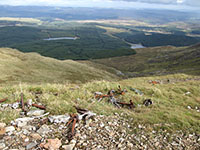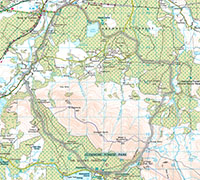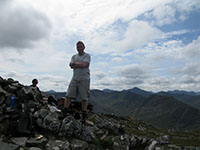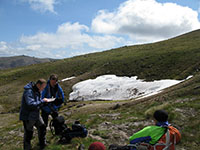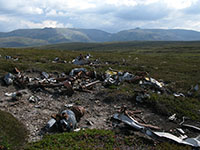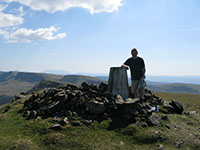Three days ago I travelled to the Galloway Hills and walked to the 814m summit of Corserine from Forrest Bridge, through a large forest plantation and steep grassy slopes. Approaching the summit via North Gairy Top, I saw the unusual sight of a herd of wild goats, although I have now seen wild goats on various mountains in Scotland, including An Teallach and Slioch in the north-west Highlands and Swatte Fell in the Borders.
Last week I met up with my friend Bernhard and we undertook a 35km cycle route in the northern Cairngorms. The route was an anti-clockwise loop starting and finishing at Loch Garten.
We took advantage of the only day with a forecast of good weather that week, and we had ideal conditions for cycling, with no wind or rain and some blue skies towards the end of the day. There were still some midgies about, but they were not too bad.
Last weekend I went on a 2-day first aid course. The course was run by First Aid Academy and was based at the Bonaly Outdoor Centre in Edinburgh. After the 2 days of the course I gained the ITC Certificate in Outdoor First Aid.
I don’t like to think of myself as a Munro-bagger (see my previous blog postings, ‘I’m not a Munro-bagger, honest‘ and ‘Munro nonsense‘), but I do keep a diary of all the hills I climb, so inevitably I also have a record of how many Munro summits I’ve got to the top of.
Last weekend I attended an Environmental Awareness course at Glenmore Lodge, as part of my preparation for the ML award.
Our group was lucky enough to get Keith Miller as an instructor for the weekend, who is a real expert on the environment of the Scottish mountains (he wrote the Invertebrate Life chapter in the SMC-published Hostile Habitats book), and who has also worked on long-lying snowpatch monitoring and research.
Last week I cycled into Glen Avon in the eastern Cairngorms with my new bike (a Giant Revel 1) from the east, starting at Corgarff Castle. The first part of the route was rougher than I expected, but the bike made it in one piece to Inchrory Lodge in Glen Avon, which is a large Victorian hunting lodge which looks rather incongrous in the remote Glen Avon, 10km from the nearest public road.
Three weeks ago I travelled to South Wales to take part in the Big Black Mountains Challenge. This is an annual long-distance mountain walk organised by the Longtown Mountain Rescue Team. I had never been to South Wales before, so walking in this part of the Brecon Beacons National Park was a new experience for me.
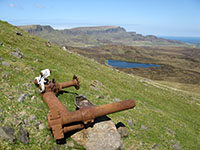
Part of the undercarriage structure from the crashed B-17, below Beinn Edra on Skye. The Quiraing behind.
During my recent trip to Skye (see my previous blog posting, ‘Skye (2)‘), I looked for the site of a USAAF B-17 Flying Fortress bomber that crashed on Beinn Edra on the Trotternish Ridge during the Second World War.
This wreck is well-known amongst locals on Skye and I have heard many discussions about it in the past, so it was good to finally visit it.
Last week Lesley and I travelled to Skye to spend a week in a holiday cottage in Fiskavaig. The weather for the first 5 days of the trip was absolutely perfect, allowing us to have a couple of barbecues in the evening with the added bonus of there being no midgies this early in the year. We saw a couple of impressive sunsets over Fiskavaig Bay with the sun disappearing behind Macleod’s Tables.

Three weeks ago I spent a couple of days in Aviemore, and went for a couple of long walks. The first was a walk through the Scots Pines of Abernethy Forest, somewhere I’ve not been to before. I had hoped to see some wildlife (including Capercaillies, which I’ve never seen before), as this is the right location and time of year to see them lekking, but I only caught a glimpse of a couple of black birds flying low though the trees and I couldn’t tell if they were Capercaillies or more probably, Black Grouse.
